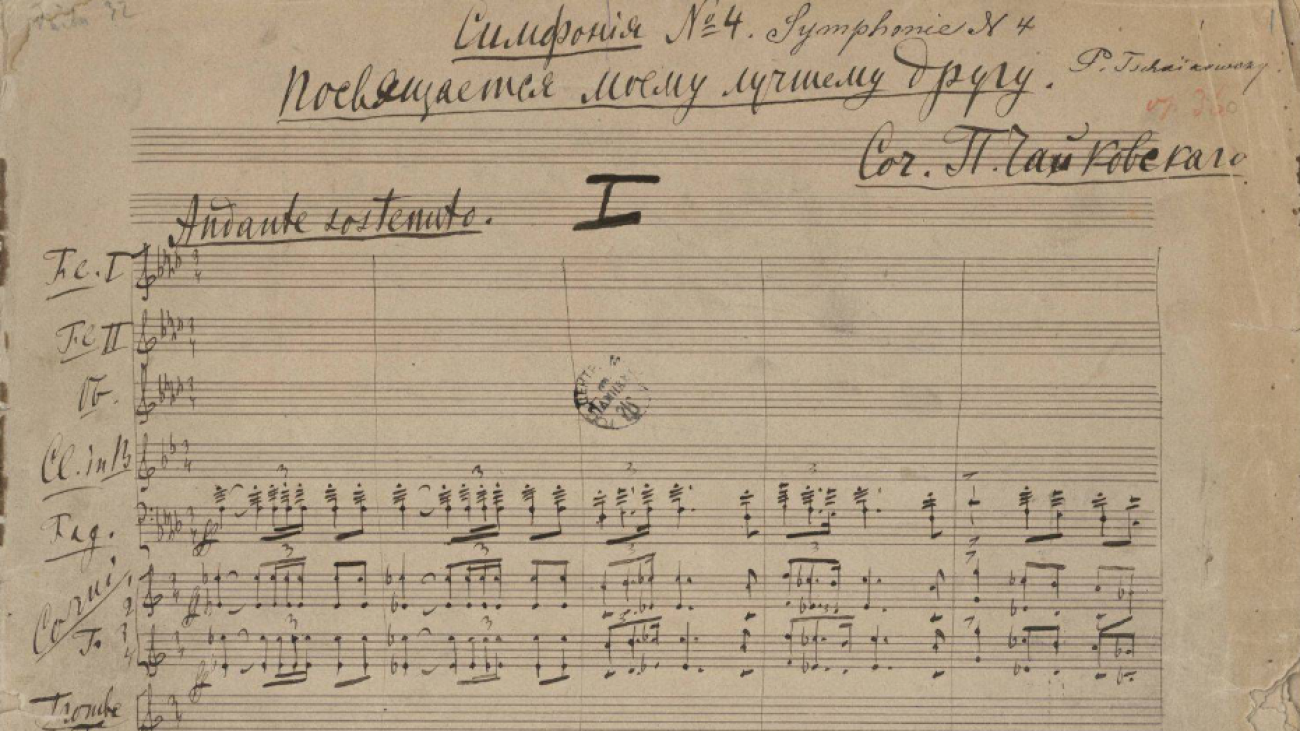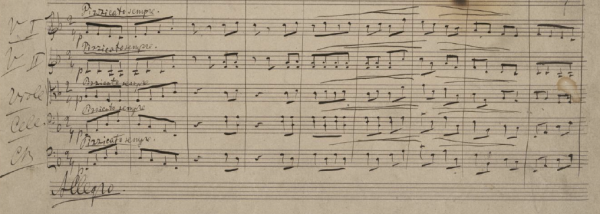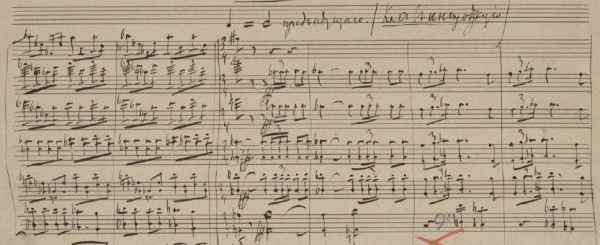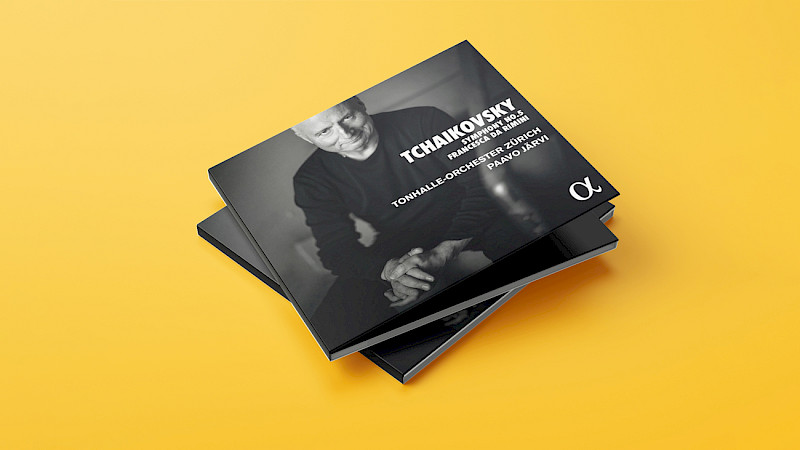
A drama of the soul
A look inside Tchaikovsky's 4th Symphony – including a first listening impression.
It may or may not be fate – Tchaikovsky's Fourth enjoys unbroken popularity. Even the self-critical Tchaikovsky believed that he had composed "not a mediocre work", but "the best" of his career to date. With its premiere on 21 January 1908 under the baton of chief conductor Volkmar Andreae, it found its way into the repertoire of the Tonhalle-Orchester Zürich at an early stage. It has been an integral part of the repertoire ever since.
The work in brief:
- Instrumentation: piccolo, 2 flutes, 2 oboes, 2 clarinets, 2 bassoons, 4 horns, 2 trumpets, 3 trombones, tuba, timpani, percussion, strings
- Composition: 1877/78
- Premiere: 10 February 1878 in Moscow, conducted by Nikolai G. Rubinstein
- Dedication: Nadezhda von Meck, "For my best friend"
Known as the "Symphony of Fate", it was composed in the immediate context of private strokes of fate. For this reason, it is a pleasure to listen to Tchaikovsky's tale of woe, which took place in 1877: his relationship with the violinist Iosif Kotek, his marriage "without love" to former pupil Antonina Miliukova, attempted suicide and flight from Moscow. Although Tchaikovsky's music is often reduced to emotional gestures, in his Fourth Symphony the composer by no means only wrote about his personal experiences.
In a word, the artist lives a double life: the generally human and the artistic, whereby the two areas do not necessarily coincide.
Tchaikovsky to Nadezhda von Meck, 24 June / 7 July 1878
For Tchaikovsky, the symphony is nevertheless "programme music". It does not refer to concrete experiences, but suggests inner moods. A drama of the soul that is impossible to verbalise. Music has immensely "more powerful means" to "express the thousand different moments of emotional experience". He told his patron Nadeshda von Meck that it could at most be an "echo" of what had happened to him personally.
I shudder to imagine what would have become of me if fate had not brought me together with you.
Tchaikovsky to Nadezhda von Meck, September 1879
While Antonina urged Tchaikovsky to marry with letters, his newfound friendship with Mrs von Meck gave him financial and, above all, emotional support. At her request - that he should describe the programme of "our" symphony to her after the previous premiere - Tchaikovsky nevertheless tried, contrary to his intentions, to translate "musical thoughts and musical images into words and sentences". PS: Naturally, however, this project had to remain "unclear and incomplete".
In the famous letter of 17 February / 1 March 1878, we read from Tchaikovsky's pen that "fate" was the main idea of the symphony. The "symphony of fate" is no longer an undescribed topos, at least since Beethoven. Tchaikovsky himself places his Fourth in direct relation to Beethoven's Fifth. He writes:
'Basically, my symphony is an imitation of Beethoven's Fifth, not in terms of its individual musical ideas, however, but in terms of its basic idea.
Tchaikovsky to Sergei Taneyev, 27 March 1878
Behind the dedication to "our" symphony hides - elegantly but unmistakably - Tchaikovsky's patron Mrs von Meck:
 "Do you think I am your friend? If you can answer this question in the affirmative, I would bevery pleased if the dedication of the symphony could simply readwithout mentioning her name: Dedicated to my friend"
"Do you think I am your friend? If you can answer this question in the affirmative, I would bevery pleased if the dedication of the symphony could simply readwithout mentioning her name: Dedicated to my friend"
Tchaikovsky dedicates the Fourth
"à mon meilleur ami",
"to my best friend"
1. Movement: This is the Fatum
An ominous wind fanfare in F minor opens the first movement. This introduction, Tchaikovsky writes to Mrs von Meck, is "the seed of the whole symphony and undoubtedly the main idea". The fanfare not only determines the course of the first movement, but also casts its shadow over the festive finale.

"This is fate, the fatal power [...] that hovers like a sword of Damocles over our heads"
Two moods contrast with each other: the "hopelessness" in the theme of the main movement, expressed in the chromatic downward movements of the unsteady "waltz" in nine-eighth time, and the "sweet and tender dream" that manifests itself in the theme of the secondary movement. Consequently, "all of life is an incessant alternation of harsh reality with fleeting dreams of happiness..."
2. Movement: Painful and sweet
An oboe cantilena in B flat minor - "semplice ma grazioso", simple but elegant - sets the tone for the second movement. Fourth and fifth falls in the melody are reminiscent of Russian folk songs. With clarinets and bassoons, the middle section of the "song movement" briefly changes to the more lively F major.

"The second movement of the symphony expresses a different kind of sadness: the melancholy that envelops you when you sit alone in the evening, exhausted from work, with a book in your hand that suddenly slips away. [...] It is painful and sweet to immerse yourself in the past"
3. Movement: Capricious arabesques
Things get virtuosic in the Scherzo: Tchaikovsky prescribes "pizzicato ostinato" for the strings. Everything is plucked and not bowed - it should sound like it is being played on a Russian balalaika. In the second part, the winds join in, with a "notorious" piccolo run in the middle.

"The third movement does not express any particular feelings. They are capricious arabesques, incomprehensible figures that float by, created by the imagination, when one has drunk wine and is a little intoxicated. [...] Then soldiers pass by in the distance. These are incoherent shapes, as if inspired by dreams when one falls asleep. They have nothing in common with reality"
4. Movement: Rejoice in the happiness of others
Furious scale runs give way to a Ukrainian folk song quotation ("A birch tree stood in the field"). This inconspicuous song theme escalates into the ominous "fanfare of fate" before the "noisy" refrain that concludes the movement and leads us back to the beginning of the symphony.

"The cheerfulness of a folk festival surrounds you. But no sooner have you forgotten yourself in the sight of strange pleasures than the inexorable fate appears anew. [...] Rejoice in the happiness of others. Life can become bearable"
Source for score illustration: https://www.culture.ru/catalog/tchaikovsky/ru/item/archiv/simfoniya-no-4
Discover more
In the Tchaikovsky section you will find concert recordings and more information about the Tchaikovsky cycle.
Translated with DeepL.com





